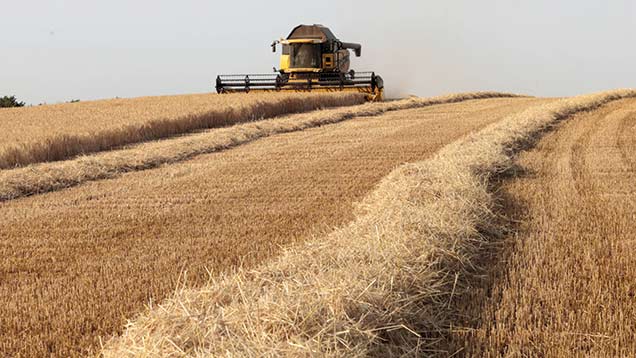Tech will unlock global market, malting barley growers told
 ©Gary Hawkins/Rex
©Gary Hawkins/Rex British malting barley growers could become world market leaders in what is an increasingly niche global market.
However, they must embrace new technology and strive to meet ever more stringent specifications, a leading West Country maltster warned.
Over the past year global barley production has fallen by 5%, as maize becomes ever more popular.
See also: Spring drilling starts in Norfolk malting barley lands
Yet in the EU and UK barley still holds a significant part of the market, said Brenda Mullen, market analyst at the HGCA.
“The EU is the powerhouse of barley production – it is becoming the go-to region for barley exports,” she added.
In the UK, barley production in 2014-15 is estimated at close to 7m tonnes for the second year running – and the 2015-16 crop could be even larger, said HGCA analyst Helen Plant.
“This year we have a potential 2m tonne barley surplus to export. With the strength of the pound against the euro, exporting to the EU has been difficult,” she added.
“But the weak pound against the dollar means we’re able to sell on to the global market. By the end of December we had shipped nearly 40% of the surplus,” Miss Plant said.
Advantages of growing barley include better blackgrass control, extending rotations, and compliance with the three-cropping rule.
However, with the increasing popularity of spring malting barley across the EU, growers should beware potentially volatile malting premiums.
“In 2014 nitrogen contents were the lowest since the 1970s. Over the past few years we’ve had benign springs, but if we get a dry spring there is the risk of nitrogen contents getting too low for brewing,” she said.
Robin Appel, grain merchant and chairman of Warminster Maltings in Wiltshire, says spring barley varieties such as Propino, Concerto, Tipple, Odyssey and Irina will comprise the lion’s share of the spring barley area due to their suitability for export.
“Since 2000, spring malting barley purchases in England have increased from about 400,000t to around 700,000t, while winter barley quantities have dropped from about 700,000t to less than 300,000t,” he said.
However, while large breweries’ market share is in decline, demand from distilleries and small real-ale brewers is growing rapidly.
“High-quality malt requires high-quality malting barley, and the barley specification ensures that the malt specification can be achieved,” said Mr Appel.
Farmers and local brewers should work more closely together to tell their stories and change public perceptions.
“St Austell brewery wants Cornish Maris Otter to produce Cornish beer,” he added.
“Although the winter barley acreage is declining, Maris Otter – at 50 years old this year – is in huge demand for craft brewers all over the world because of its exceptional flavour profile: There’s nothing to challenge it,” Mr Appel said.
One significant change to come in this year is the lowering of the maximum moisture content from 15% to 14.5%.
“Two maltsters have already introduced this, and it will be industry-wide from 1 November 2015,” warned Mr Appel.
The change follows research showing that storing malting barley at high moisture for even a short period of time can result in fungal growth, potentially leading to development of the dangerous mycotoxin ochratoxin A.
“We’ve failed to get the importance of this across to growers, and merchants who already have maximum 15% contracts in place may have to renegotiate,” said Mr Appel.
On a more positive note, talks are under way between Water UK and the malting industry with a view to licensing the use of sewage sludge on malting barley crops, he added.
“There will soon be a sewage sludge assurance scheme in place. They have addressed all the potential problems and to my mind sewage sludge will be far cleaner than farmyard manure; it’s got to be the way to go,” Mr Appel said.
Plans are also afoot to update RB209’s recommended nitrogen fertiliser rates, to take account of sharp increases in yields since the 1980s, said Phil Bounds from Adas.
“A new HGCA project shows you get a 0.5t/ha yield increase from applying more than 50% of nitrogen before early stem extension in winter barley – and you also get a consistent 0.1% reduction in grain nitrogen,” he explained.
Straw yields and height increase too, so farmers must be careful to apply plant growth regulators accordingly.
Maximising green leaf area between emergence and flowering will boost yields through increasing grain numbers, added Mr Bounds.
“Green leaf area after ear emergence is not so important. So you need to look at early sowing at higher seed rates, with early disease control, and more early nitrogen fertiliser,” he said.
Winter barley crops with a yield potential above 8t/ha also require an extra 27kg N/ha for every extra 1t/ha – although farmers must take account of the farm’s N-max limit.
Spring barley requires an extra 20kg/ha per tonne of yield above 5.5t/ha – but the recommended timing of applications remains unchanged.
Brenda Mullen, Helen Plant, Robin Appel and Phil Bounds were all speaking at an HGCA-organised malting barley breakfast in February.

